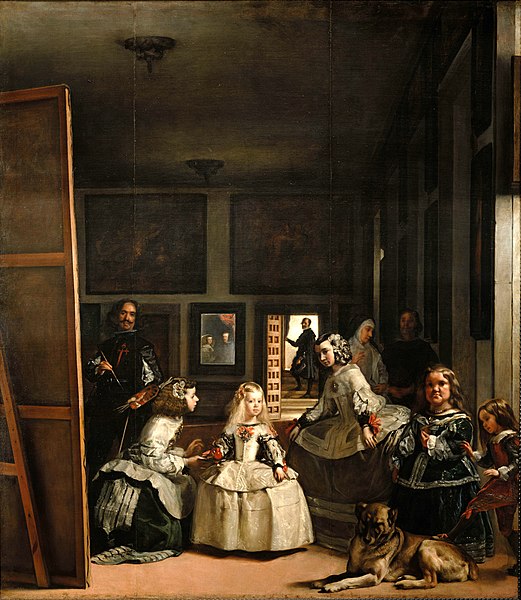All AP Art History Resources
Example Questions
Example Question #1 :Understanding Terminology That Describes Seventeenth And Eighteenth Century 2 D Art
The artistic device in which an object in a painting is made to look like an object on the painting is known as__________。
trompe l'oeil
marbleizing
photorealism
perspective
trompe l'oeil
French for "deceive the eye,"trompe l'oeilis the painting technique where the artist makes an image that appears three dimensional and outside the painting. The concept goes back to Roman art, where walls in houses would have fake windows of iterms painted on, but was first defined in the Baroque era. The technique can be used to either enhance the dimensionality of a painting, or as a kind of artistic joke, featuring a "mistaken" element.
Example Question #2 :Understanding Terminology That Describes Seventeenth And Eighteenth Century 2 D Art
Both images feature a figure that is a__________。
self-portrait
caricature
grotesque
demon
self-portrait
Each painting features a remarkable realism in its portrayal of the figures included therein, including a self portrait of the painter. Francisco de Goya likely included himself in his painting as a nod to Velázquez' own self-portrait inLas Meninas, with both standing behind an easel placed in the left side of the painting. Both painters include themselves to make the viewer rethink what they see in the painting of royalty, with the gaze of the painter staring back at the viewer.
Figure 1:Las Meninasby Diego Velázquez (1656)
Figure 2:Charles IV of Spain and His FamilyFrancisco de Goya (1801)
Example Question #21 :年代eventeenth And Eighteenth Century 2 D Art
The painting shown in Figure 3 uses the technique known as__________。
impasto
trompe l'oeil
abstraction
chiaroscuro
chiaroscuro
Chiaroscuro is an artistic term denoting a strong contrast between dark and light elements. First developed and defined in Italy in the late sixteenth century, chiaroscuro was a key element of Rembrandt van Rijn's style. InThe Night Watch,he throws significant light on the group's leaders exiting the hall, with shadow taking over those in the back.
Figure 3:The Night Watchby Rembrandt van Rijn (1642)
Figure 4:The Astronomerby Johannes Vermeer (1668)
Example Question #2 :Understanding Terminology That Describes Seventeenth And Eighteenth Century 2 D Art
年代ir Anthony van Dyck's portraits helped popularize the clothing referred to as
"Roundhead" style.
"Cavalier" style.
"Continental" style.
"Rococo" style.
"Cavalier" style.
The "Cavalier" dress refers to men with flowing ringlets, high leather boots, brightly colored fabrics, lace collars, and elaborate trimmings.The word "Cavalier" described the Royalist factions in the English Civil War (1642-1651), although Van Dyck painted portraits of Royalist and Parliamentarian leaders before the war. In fashionable portraiture over the next centuries, especially in England, "Cavalier" style was a popular way to be presented.
Example Question #3 :Understanding Terminology That Describes Seventeenth And Eighteenth Century 2 D Art
A "triple portrait" is a work of art that features the subject__________。
from three different angles
in three different settings
at three different ages
in three different costumes
from three different angles
最著名的是“三重肖像”年代ir Anthony van Dyck painted of King Charles I of England in 1635 or 1636. The painting was supposed to be used as a model for a bust, and the three different angles of Charles' face were intended to allow for a possible three-dimensional model. The painting became widely copied in the next few centuries, as it not only showed off the subject but also exhibited the skill of the artist.
Example Question #23 :年代eventeenth And Eighteenth Century 2 D Art
What is the function of the orrery that the people are looking at?

It shows the movement of the solar system
它显示了光与影之间如何交互ther
It is a model of the earth and demonstrates its rotation
It is a large model of an atom and demonstrates how it functions
It shows how gravity works
It shows the movement of the solar system
An orrery was an early form of planetarium, and it was meant to show how the planets move in the solar system. The light projecting from the left side was meant to represent the sun. The philosopher is demonstrating what happens during an eclipse in this image.
Image is in the public domain, accessed through Wikipedia Media Commons: https://en.wikipedia.org/wiki/File:Wright_of_Derby,_The_Orrery.jpg
Example Question #24 :年代eventeenth And Eighteenth Century 2 D Art
Which of the following artistic techniques is used in一个哲学家给太阳系仪上的讲座?

Contrapposto
年代fumato
Burnishing
年代tippling
Tenebrism
Tenebrism
Wright uses tenebrism in一个哲学家给太阳系仪上的讲座。暗色调主义是使用非常对比灯和darks, to the point that the the darkness dominates the image. This then emphasizes the light spots even further -- in this painting, the parts lit by candlelight are very noticeable in comparison to the rest of the image. Wright painted several "candlelight pictures," and he was influenced by Caravaggio, who also made use of tenebrism in many of his works.
Image is in the public domain, accessed through Wikipedia Media Commons: https://en.wikipedia.org/wiki/File:Wright_of_Derby,_The_Orrery.jpg
Example Question #4 :Understanding Terminology That Describes Seventeenth And Eighteenth Century 2 D Art

The painter of this portrait can be guessed by which defining feature?
Use of vibrant color
Use of unconventional textures
Use of chiaroscuro
Use of visible brushstrokes
Use of an older subject
Use of chiaroscuro
As a Rembrandt portrait, the most notable and identifiable quality of the painting is its chiaroscuro lighting, or its use of extreme light and shadow. Rembrandt was not known for visible brushstrokes or vivid colors, and neither are on display here. The textures are not especially unconventional, and in any case that fact and the use of an older subject are not immediate signifiers of Rembrandt's work.
Image is in the public domain, accessed through WikiArt: http://www.wikiart.org/en/rembrandt/old-man-with-turban
All AP Art History Resources









